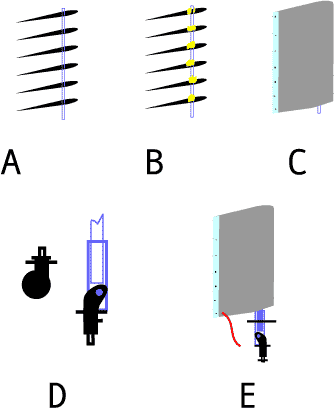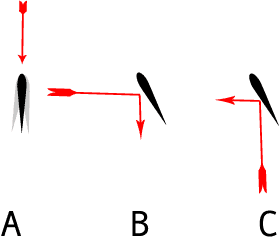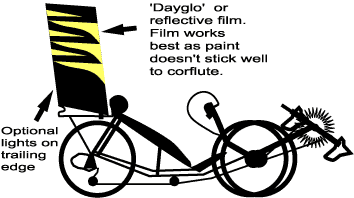|
|
|
It's wise to use safety flags when riding recumbent vehicles. Recumbents present a smaller profile to traffic and are below the line of sight for drivers reversing.
The flags have a disadvantage - they're not aerodynamically efficient. Quite frankly, I find the flapping of two flags quite annoying. What if we could present a large visible surface with minimal wind resistance? I was motivated by the fin on the 'Carcycle' to design this safety sail. Even though it's small, this fin also produces thrust on windy days.
A note of warning: You must decide on the size of fin that will not destabilise the trike in cross winds. I added front wheel discs to balance the side thrust. Experiment in areas with no traffic before exposing your rig to the streets.

A: Cut airfoil ribs from corflute and thread on to an aluminium tube. To thread the ribs on to the tube, cut a cross centred on the spar position and push through with a blunt taper to form a square hole. The gaps work to your advantage by allowing foam through to support the rib.You can get an airfoil from the NACA site on the Web. Bob Stuart (the inspiration for this project) suggests a NACA 64-015 to get a wide range of angles of attack without stall along with low drag and good lift.
B: Line up the ribs by sighting along the trailing edge. Squirt a blob of expanding foam on and through the hole to position the ribs. The foam sticks to the tube and mechanically locks around the rib. The foam doesn't bond well to the corflute, so make sure it's both sides of the rib and continuous through the hole.
C: Measure a rectangle of corflute and lightly score down the centreline leading edge. This will be the outside and form a neat fold. I pulled the corflute around one rib and pushed a fine wire through to hold the wrap against the ribs, bending the wire over to pull the wrap tight against the rib.Squirt a little foam along the edge of each rib, top and bottom, to add support. Temporarily clip the trailing edge together (wire ties again). Wait for the foam to set (overnight is best), then trim the trailing edge, rivet it with bifurcated rivets (split rivets) and tape over the rivets with duct tape. I also ran a hot glue gun down the traling edge. To finish it off, cut a rib and hot glue it into the top.
D: Remove the wheel from a steel ball bearing caster. Turn it upside down and mount a receiving tube where the wheel was, using the same bolt. Fasten the bottom of the tube with a self tapping screw or another bolt to stop the tube from tilting.
E: Slide the wing sail spar down into/over the receiving tube and drill through for a retaining pin. I used coat hanger wire. It's strong enough and you can demount the sail by removing the pin. I mounted the sail using the original caster bolt through the pannier shelf close the the front.

A: Head wind. Minimal added resistance. Fin will feather into wind according to direction.
B: Wind abeam. Forward thrust generated as fin is pushed downwind to limit of trailing edge cord.
C: Tail wind. Forward thrust generated as fin swings to limit either side.
Limit the angle of the fin to about 30 degrees either side of centreline with a length of light bungee. Arrange the bungee so that the wing swings to about 25 degrees freely then takes up the tension on the bungee cord.

Eeeehaaaaaa.
With a strong side wind, the trike came alive. I could feel the gusts 'lifting' the trike a little. There was no effect on stability and a only minor amount of steering correction was needed. I put this down to the balancing effect of front wheel discs and the fact that the sail pivot is ahead of the rear axle. I cruised on level ground at 44 kph (26 mph) and didn't break sweat.
With a tail wind, the sail locked over and what can I say.... it pushed. I got off the trike to adjust the halyard and had to grab the trike to stop it moving away.
In a head wind it was that damn head wind again. The sail feathered. It must have added to the front profile and caused additional drag. There was a whistle from the cut in the corflute leading edge, so my next one will have to be better made.
With the wind forward of the beam, but not a head wind, the trike seemed easier to pedal and didn't slow down quickly. We seemed to coast a long way.
Observations:
The pivot would benefit from being damped - oil damping would be the best, but a friction damper would work. I need to stop it 'whipping' in turbulent air.
The bungee broke almost immediately. I replace it with a length of nylon cord on the road and that seemed to work better. I think a rigid cord with a shock spring on the end will work best.
The pannier is not strong enough for an usupported mast. There's too much flex. I'll build an aluminium frame that distributes the forces more evenly over the trike frame. As usual I underestimated the force of the wind. The inner spar separated from the ribs and rotated. It didn't stop it working, but obviously expanding foam just ain't up to the job. The fin retained it's shape because the foam encapsulates the ribs.
I think the concept works well enough to justify making alloy ribs and pop riveting them to a spar.
Conclusion. It's a total successful as a safety sail - it's big, bright and 'out there.' It definitely gives thrust (not a lot - it's only 1/3rd of a square meter). In this size and configuration there was no feeling that the sail reduced stability. I'll make the next one about 2/3rds of a square meter. From the feeling of this one, anything larger will overpower the mounting point. 1.2 meters by 500mm wouldn't be unreasonable
A big thanks to the alt.rec.bicycles.recumbent Newsgroup and the Trikes list at http://www.ihpva.org/mailman/listinfo/trikes These resources constantly educate me in the field of recumbent cycling and trike ownership.
Easy
to make airfoil finA
lift generating safety sail
What
happened when I road tested it?